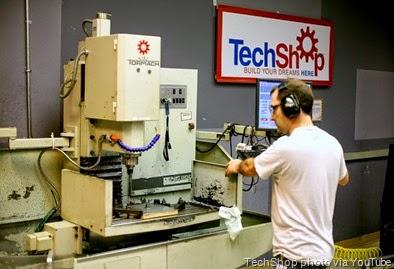 Back in the early 2000s, the Maker Movement took hold in California, based on the emergence of such do-it-yourself (DIY) tools as 3-D printers, Google's SketchUp and makerspaces such as TechShop, with all the tools you need to make almost anything. Thus entrepreneurs began building prototypes and designing new products without the traditional huge investment.
Back in the early 2000s, the Maker Movement took hold in California, based on the emergence of such do-it-yourself (DIY) tools as 3-D printers, Google's SketchUp and makerspaces such as TechShop, with all the tools you need to make almost anything. Thus entrepreneurs began building prototypes and designing new products without the traditional huge investment.
The movement has spread across the country and across the globe, spawning innovative products such as the MakerBot Digitizer and all the things you can download from Thingiverse.com. Events for enthusiasts, called Maker Faires, now stretch far outside California to places such as Detroit, New York and even Shenzhen, China. A recent California event packed in 100,000 people.
I believe the Maker Movement and startups are made for each other. Here are some key positives from an entrepreneur perspective:
-
Shorten the time and cost from idea to prototype. In today’s fast moving market, the basic product development cost and time are critical to survival. They come at the early stage while a startup has no revenue or valuation, so professional investors are hard to find. Low-cost design and fabrication tools are extremely valuable.
-
Place to build skills and become familiar with new tools. Makerspaces, sometimes called hackerspaces, have sites and events, including tutorials, where people with common interests can meet, socialize and collaborate. With the new rapid prototyping tools, products can be physically built for analysis, rather than just conceptualized.
-
Network with potential cofounders and strategic partners. Relationships are best built while working and learning together, rather than over drinks at a mixer or industry conference. There are already more than 500 active hackerspaces worldwide, as listed on Hackerspaces.org. Countless startup teams have already been spawned from these.
-
Opportunity to meet investors and support organizations. Venture capitalists and investors are where the action is, to see first-hand what is possible, and who are the leaders. Makerspaces are becoming the new incubators and accelerators for startups, and support contacts, like lawyers and marketing groups, will be easy to find.
-
Open your mind to new entrepreneurial opportunities. With low-cost digital design and fabrication tools, such as 3D printing and the ability to digitize almost any object, bold new innovations become apparent. Very young entrepreneurs get to “touch and feel” the results, and can experiment to their heart’s content. These ideas can grow quickly into real products.
-
Meet the new consumer demand for customization. Customers today increasingly demand solutions that are customized just for them. Hobbyists and craftsmen have made custom solutions for a very long time, but companies have resisted this requirement to keep costs down. Maker tools are changing these economies of scale.
-
Accelerate the trend to higher purpose startups. The new do-it-yourself capabilities and low entry costs mean that you don’t have be a Bill Gates to offer solutions that have an impact on society. The Maker Movement is already poised to transform learning in our schools, and offer low-cost solutions to solve environmental and third-world problems.
-
Diversity breeds success. By collaborating with the Maker Movement, artistic entrepreneurs work with the technology freaks, and both benefit from other cultures around the world. New products emerge, as diverse as networked-art installations, Internet-of-Things innovations, and many other hybrid software-hardware solutions.
Makers are becoming real entrepreneurs, rather than just hobbyists and inventors. The new shared culture emphasizes learning-through-doing in a social environment, as well as fun and self-fulfillment. Have you tried it yet?

